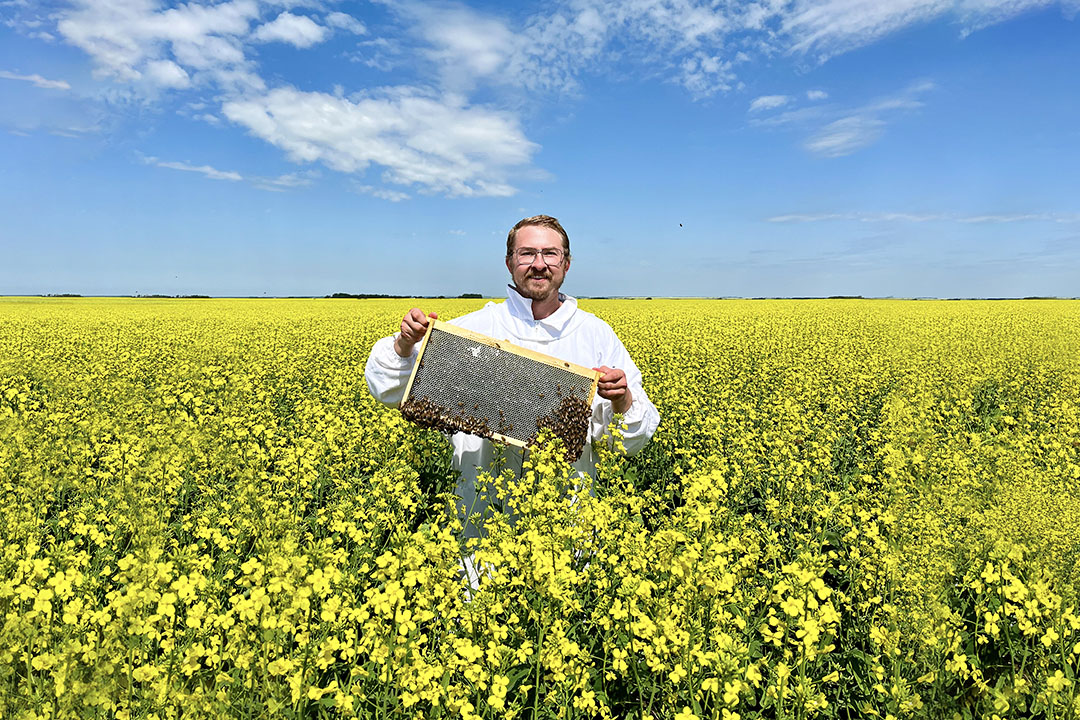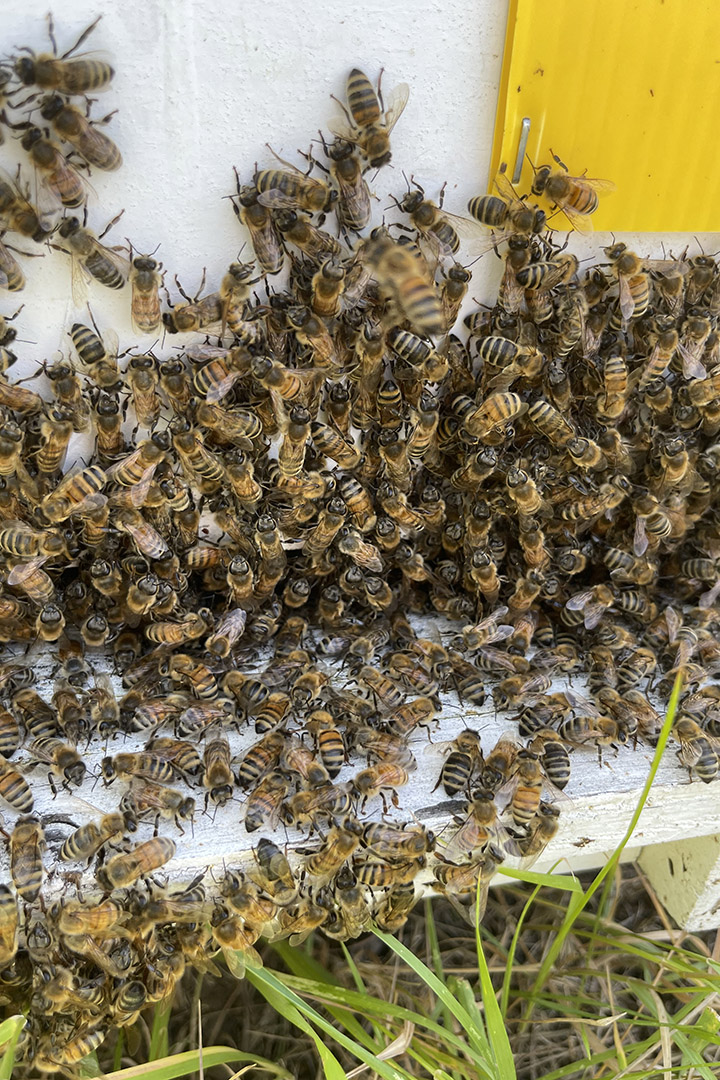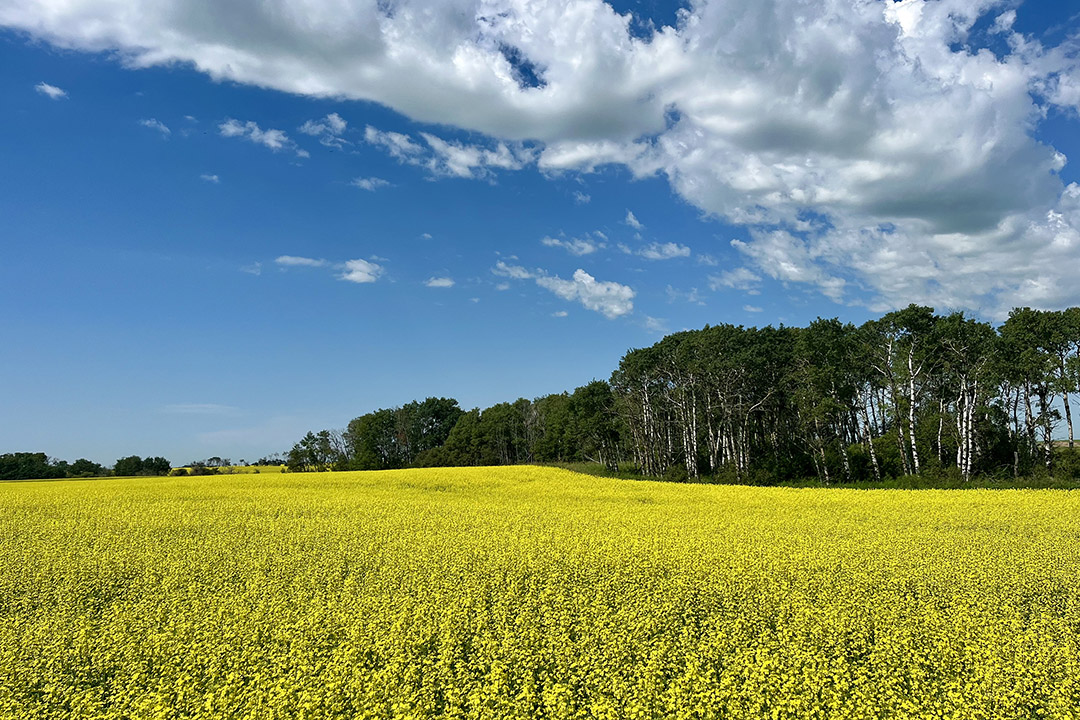
Flying beyond the yellow: USask scientists explore honey bees’ diverse foraging habits on Prairies
This summer, I teamed up with honey bee researchers at the University of Saskatchewan (USask) to learn more about the foraging habits of the pollinator species on the Prairies where canola is a dominant source of high quality nectar.
By Justin Slobodian
Examining the foraging habits of honey bees can help beekeepers to properly place their hives in areas where the insects can flourish, and this knowledge can aid in maximizing the production and health of honey bees.
Healthy bees mean increased pollination that helps to increase the yield of many flowering plants — such as canola. Higher yields mean greater food production, which can translate into lower prices at the grocery store for consumers.
Beekeepers on the Canadian Prairies generally strive to have their honey bee colonies located near vast yellow seas of canola, and since this oilseed plant only flowers for about 20 days, it means the window of time for honey bees to collect nectar is very short.
Canola’s yellow blossoms yield high quality nectar that supply bees with the carbohydrates they need for energy. For example, one hectare (2.5 acres) of flowering canola is enough to supply a colony with an entire year’s worth of food.
While bees get the sugar they require from the nectar of plants for honey production, they receive essential fats and proteins from plant pollen. Ensuring proper nutrition allows bees to increase their population and develop properly. As well, it helps them survive when faced by stressors such as pathogens, poor weather, or times of scarcity.
But in a region where canola fields are so plenty, do honey bees derive all of their nutrient needs from this single crop?
“In the past, it has been thought that more surrounding canola correlates with more honey production,” says Dr. Marcelo Camilli (PhD), a postdoctoral fellow and member of the honey bee research lab at the Western College of Veterinary Medicine (WCVM).
Now, Marcelo and his research colleagues think that despite having access to canola as far as the eye can see, honey bees choose to navigate to origins of other plants and collect a diverse buffet of protein-packed pollen.
“Just as we choose foods that benefit our health, we believe honey bees are also able to diversify their diet with different types of pollen from different flowers to give them the proper nutrition they require to flourish,” says Marcelo.

Since 2023, the honey bee research lab has been conducting field studies to learn more about the foraging habits of bees. This summer I joined “the canola team,” which consisted of me, Marcelo and Emilio Tellarini, a USask master’s student from Argentina. Our supervisor was Dr. Elemir Simko, a professor in the WCVM’s Department of Veterinary Pathology who has been conducting honey bee research at the college for many years.
As part of our research study, we set up 15 apiaries (locations where bee hives are kept) in the Saskatchewan canola belt. These apiaries are scattered across the province — from Unity in the northwest to Wadena in the southeast — and each have four honey bee colonies in their respective hive. Each hive is placed on an electronic scale that takes hourly weight readings — enabling us to see trends of weight gain that we can use as a proxy for honey bee production.
When the canola fields were in full bloom, we visited each site to download scale data and to close pollen traps that are installed on each hive’s entrance. When bees return from foraging, they must squeeze themselves through this tight entrance. This snug squeeze causes the pollen pellets carried on their legs to fall off into a collection basket.
We returned in 24 hours to open the traps so that we didn’t starve them of this important resource. Then we collected and analyzed the pollen to let us know what types of floral sources these colonies are visiting.
Last year, the researchers found that only canola pollen was present in honey collected during canola bloom, but the majority (50 to 85 per cent) of the pollen captured by the traps was from non-canola flowers. These findings suggest that during canola bloom, bees collect the majority of nectar for honey production from canola flowers, whereas pollen seems to be “consciously” collected from a variety of blossoms — presumably to ensure the diverse protein and fat diet.
In addition to this study, we’re gathering more information from the same honey bee colonies for other projects. Marcelo is testing honey, pollen and surrounding soil as well as the bees themselves to evaluate levels of pesticides. Emilio is also conducting a study on wild pollinators to see what other species of insects are attracted to canola crops.
When I asked Marcelo about the next step for studying honey bee production in the Prairies, he believes that we need to dive deeper into understanding the exact nutritional value of pollen. That information can help us to identify why bees choose to travel great distances rather than chow down on food that’s literally on their doorstep — swaying in the wind.
This research project received financial support from SaskOilseeds, Saskatchewan Agriculture Development Fund, Mitacs, BASF, Saskatchewan Beekeepers Development Commission, Boehringer Ingelheim and the WCVM’s Interprovincial Undergraduate Summer Research Program.
Justin Slobodian of Saskatoon, Sask., is a second-year veterinary student at the WCVM who worked as a summer research student in 2024. His story is part of a series of articles written by WCVM summer research students.
Together, we will undertake the research the world needs. We invite you to join by supporting critical research at USask.
